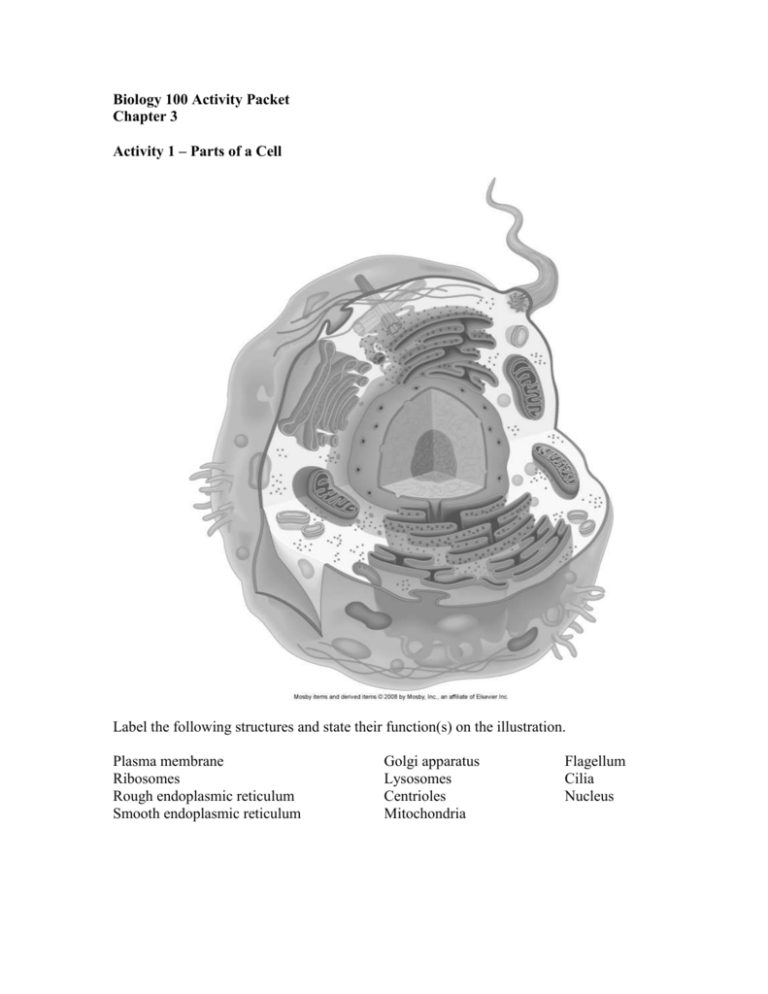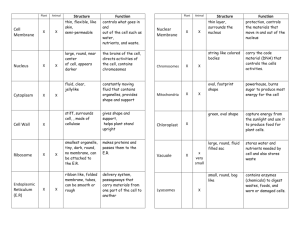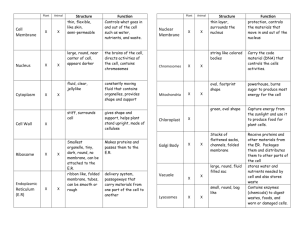Chapter 3 - ProfGillespie.com
advertisement

Biology 100 Activity Packet Chapter 3 Activity 1 – Parts of a Cell Label the following structures and state their function(s) on the illustration. Plasma membrane Ribosomes Rough endoplasmic reticulum Smooth endoplasmic reticulum Golgi apparatus Lysosomes Centrioles Mitochondria Flagellum Cilia Nucleus Activity 2 – Mitosis In this activity you will use simple models of chromosomes made from pipe cleaners to show a cell in the various phases of mitosis. You will also need a few sheets of blank paper and something to draw with. Follow the directions for each phase. Interphase 1. Take a sheet of paper and draw circle on it large enough to fill the page. This represents the cell’s plasma membrane. 2. Draw a smaller circle (about 3 inches in diameter) in the center of the larger circle. This represents the cell’s nuclear membrane. 3. Start with the following pieces of pipe cleaner: 1 long and 1 short red piece, 1 long and 1 short green piece. These represent four chromosomes while the cell is in between cell divisions. Place the chromosomes somewhat randomly inside the nucleus. 4. Draw a pair of centrioles somewhere outside of the nucleus. (Don’t worry about showing other organelles.) 5. Before a cell can divide it must first replicate all of its chromosomes. Take the remaining pieces of pipe cleaner from the bag and cross them over the matching pieces so each chromosome looks like an X. Each piece in the pair is now called a sister chromatid. 6. Also draw a second pair of centrioles near the first pair, as two pairs are needed to complete mitosis. 7. Show your instructor your model before moving on to the next phase. Prophase 1. On either the back side of your first sheet of paper or on a fresh sheet, draw a new circle to represent the cell membrane. It should be the same size as the first. 2. Draw a new nuclear membrane, but this time use a dashed line. This represents the dissolving of the nuclear membrane. 3. Draw the pairs of centrioles so that they are farther apart from each other. Add some lines that radiate out from each pair. Have some lines extended toward the nucleus, have other extend toward the cell membrane. These lines represent the spindle fibers. 4. Remove the chromosomes from the nucleus for the moment. Take each pipe cleaner and fold it in half, then twist the ends around each other. This represents the condensation of the chromatin into visible chromosomes. 5. Repeat the above step for the remaining pieces. 6. Take the matching pieces and cross them over each other again, then place them randomly back inside the nucleus. 7. Show your instructor your model before moving on to the next phase. Metaphase 1. Take a new sheet of paper and draw another large circle as before. Do not draw a smaller circle this time. 2. Draw your centrioles at opposite ends of your cell. Do not draw spindle fibers yet. 3. Move your chromosomes so they are all in a straight line that runs perpendicular to an imaginary line that connects your two pairs of centrioles. 4. Now draw spindle fibers. Have one fiber extend from each pair of centrioles toward the center of each chromosome. When done each chromosome should be connected to each pair of centrioles. 5. Show your instructor your model before moving on to the next phase. Anaphase 1. On either the back side of your sheet of paper or on a fresh sheet, draw a new plasma membrane, but this time draw it so that it looks “pinched in” on opposite sides. This represents the beginnings of cytokinesis. 2. Draw the pairs of centrioles on opposite sides, but do not draw spindle fibers yet. 3. Move your sister chromatids in opposite directions so that each one is closer to one of the pairs of centrioles. 4. Draw spindle fibers so that only one fiber from a centriole is connected to a chromatid. 5. Show your instructor your model before moving on to the next phase. Telophase 1. Take a new sheet of paper and draw another plasma membrane, but this time make the “pinches” even deeper so that the membrane is almost split in half. 2. Using dashed lines draw two new nuclear membranes on opposite sides of the cell. 3. Unwind your chromatids back into chromatin and place a set in each nucleus. 4. Draw a pair of centrioles at each end of the cell, but do not draw spindle fibers. 5. Show your instructor your model when you are finished. Activity 3: Tissue Characteristics Pretend you are working in a hospital laboratory where it is your job to examine tissue specimens under the microscope. Read the following descriptions and identify the correct type of tissue. Be as specific as possible. 1. This specimen has many layers of cells. The cells in the top layer are flat, but still have nuclei within them. The cells at the bottom are rectangular in shape and separated from a fibrous tissue layer by a thin membrane. ______________________________________________ 2. This specimen consists of many long, tubular cells. The cells all have a pattern of alternating light and dark bands. Each cell has several nuclei located along its outer edges. ______________________________________________ 3. This specimen has many thick fibers arranged in a haphazard pattern. The cells are scattered about the tissue rather than being connected to one another. ______________________________________________ 4. This specimen has a few large cells with many branches extending off of the area containing an obvious nucleus. There are many smaller cells occupying the area in between the larger cells. ______________________________________________ 5. This specimen appears to have many layers of cells. Upon closer inspection you see that although they are all attached to a supporting membrane at the bottom, not all of the cells reach up to the top. The cells that do reach the top all have what look like tiny hairs on their surface. _______________________________________________ 6. This specimen consists of many short cells with a single nucleus in the center of each. The cells have a faint pattern of banding on them, and are branched at the ends. There also appears to be a dark structure located at the point where two adjacent cells touch each other. ________________________________________________









